East Wall Evictions Commemoration
If, like me, you missed this important 1913 commemoration (I missed train connection from Cork, what’s your excuse?) you can see highlights on this Youtube link

If, like me, you missed this important 1913 commemoration (I missed train connection from Cork, what’s your excuse?) you can see highlights on this Youtube link
Following three rounds of competition, the Irish Writers’ Union are pleased to announce the following have made the final shortlist of nine for the James Plunkett Short Story Award.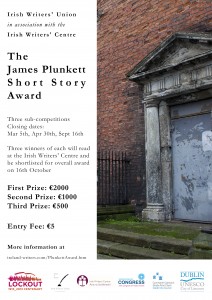
Noel O’Regan, “Hoax”
Fiona O’Connor, “The Mystery of the Missing Finger and the Dead Cat”
Maureen Gallagher, “Apparition at Friars Hill”
Eleanor O’Reilly, “Coagulated Blood and Dread”
Chris Dooley, “Bookworm”
Barry Troy, “In for a Penny”
I Could Have Been Anything, “Anne O’Brien”
The Hill Farms Are Dying, “Patrick McCusker”
The Peace of Evening, “Eileen Keane”
Almost uniquely in Irish consciousness, the 1913 Lockout is remembered and accessed almost exclusively through literature. The events and the legacy of 1913 are often difficult to interpret. In his seminal book, ‘Strumpet City’, James Plunkett takes the events of 1913 and weaves them into a format that is instantly accessible: the humble story.
Thus, it is very fitting that, in 2013, a major short story award has been launched and named in Plunkett’s honour.
The award brings together the Irish Writers’ Union, the Irish Writers’ Centre, the Unesco City of Literature committee, Dubin City Council, the Dublin Library Service, the 1913 Committee and ICTU under a banner that seeks to celebrate Plunkett’s great skill as a social commentator. Entrants were asked, simply, to recall Plunkett when writing.
A sincere congratulations to those who have been shortlisted. The quality of the entries has been of a standard that demonstrates the strength of the continued Renaissance of the short story in Ireland.
The final will take place in the Irish Writers’ Centre at 7:30 on 16th October. The winners will be selected by Jennifer Johnson.
The 1913 Tapestry was launched by President Higgins, in Liberty Hall on 18th Sept. 2013.
This tapestry tells the story of many events which took place in 1913.
There are 29 pictures -panels- depicting those events. These are grouped together on nine white “pages”, so that the exhibition is presented as reading a large “comic”. A clear narrative links the story together.
It was commissioned by SIPTU and the NCAD.
The artists are Robert Ballagh and Kathy Henderson.
The sketches were based on original photos of the time. These were sent to a printer, and then transferred to panels of linen, 3ft by 2 ft. each, using a light box.
These panels were then distributed to 29 groups throughout the country such as Irish Patchwork Society, The Embroiders Guild, Blanchardstown ICA, People in Rehab, The Abbey Theatre, and art and craft groups as in East Wall, Clondalkin and Limerick.
The New Ross Tapestry and the Quaker Tapestry are beautiful examples of needlework. (more…)
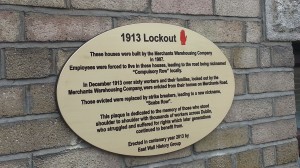 During the 1913 Lockout over sixty East Wall families were evicted by the Merchants Warehousing Company. The photograph above is a particularly
During the 1913 Lockout over sixty East Wall families were evicted by the Merchants Warehousing Company. The photograph above is a particularly 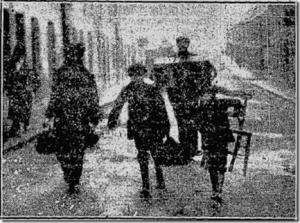 haunting image, showing an evicted family carrying their possessions along Merchants Road. The other two photographs, while not as poignant, also illustrate the events of that day. The first shows bailiffs gathered at a door about to serve an ejectment notice on a family, while the second is evicted residents with their furniture placed in front of their former home.
haunting image, showing an evicted family carrying their possessions along Merchants Road. The other two photographs, while not as poignant, also illustrate the events of that day. The first shows bailiffs gathered at a door about to serve an ejectment notice on a family, while the second is evicted residents with their furniture placed in front of their former home.
The quality of these images is poor; however, as no other copies are currently available to us we feel that they are of such historical importance that they should be published.
Images can fade, but memories should not. Next Sunday,15thSeptember a commemorative event to remember the families evicted during the 1913 Lockout is taking place – an impressive new mural depicting an eviction scene along with a plaque on the Merchants houses will be unveiled.
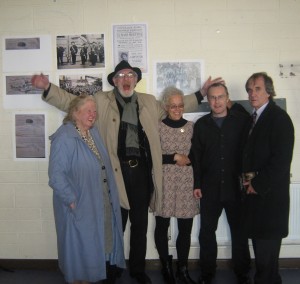
Mae Mac Giolla, Jer O’Leary, Sarah Lundberg, Joe Mooney and James Connolly Heron at Event Evictions commemoration
For More Pictures see www.Eastwallforall.
Here is a good take on the Lockout and Unions from the BBC – 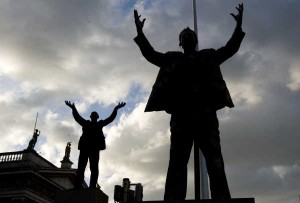
http://www.bbc.co.uk/go/em/fr/
and for anyone who missed Philip Bromwell’s piece on the Lockout Tapestry in RTE’s 6.01 News
http://www.rte.ie/news/player/
The item is 33 minutes and 20 seconds in
And don’t forget last in series of wonderful Athena Media documentary series is on RTE tonight – September 14th
Christopher Lee follows his ground breaking account of the Lockout in Swords with this account of Frank Moss, the leader of the Swords strikers in the Lockout of 1913. 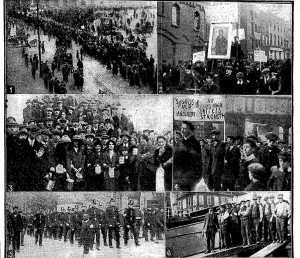
A century after the events of 1913 the names most closely associated with the Dublin Lockout are of course those of James Larkin, James Connolly and William Martin Murphy. The names of those persons killed or injured during the Lockout are also remembered, such as James Nolan, John Byrne, Alice Brady, James Byrne and even Patrick Daly.
However, Frank Moss, a union organiser who played a major role in the County Dublin farm labourers’ dispute, was imprisoned twice, went on hunger strike twice and was force fed on both occasions, and was a founding member of the Irish Citizen Army, has been forgotten.
See also Christopher’s articles on the Lockout inFinglas and Swords on the www.Irishstory.com site
Artist Rory Breslin describes how he came up with the design:
Taking cognisance of the size of the finished coin and need for simplicity, the coin represents the images I believe most of us have in our minds when conjuring up the 1913 Lockout …. the crowds on the streets of the working and middle class, the locks and closed gates of industry and the iconic image of Jim Larkin, arms outstretched in an encouragement of unity.
The design has as its background the crowds, men with soft caps as was the norm and women in hats. The inclusion of women is important because while most of the historic images depict mainly men on the streets at meetings, this was an event that had an enormous impact on whole families. The depiction of the crowd in the bottom third of the coin gives the overall image a pictorial grounding. (more…)
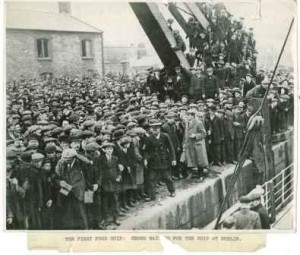 For those who missed the Fifth Part of the RTE Radio Documentary by Athena Media on the Lockout ‘Citizens’ last Saturday you can click on the podcast link below
For those who missed the Fifth Part of the RTE Radio Documentary by Athena Media on the Lockout ‘Citizens’ last Saturday you can click on the podcast link below
http://www.rte.ie/radio1/
The next episode is at 6.06pm on Saturday, September 14th, 2013
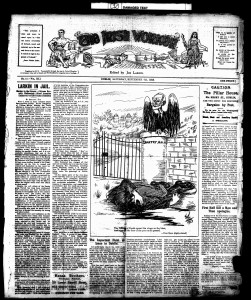 ON THE MORNING of Tuesday 25 April 1916 Ernest Kavanagh was shot dead on the front steps of Liberty Hall, the headquarters of the Irish Transport and General Workers’ Union (ITGWU) where he was employed as a clerk. One of several hundred civilians to be killed during the Easter Rising, the Dubliner was 32 years old at the time of his death.
ON THE MORNING of Tuesday 25 April 1916 Ernest Kavanagh was shot dead on the front steps of Liberty Hall, the headquarters of the Irish Transport and General Workers’ Union (ITGWU) where he was employed as a clerk. One of several hundred civilians to be killed during the Easter Rising, the Dubliner was 32 years old at the time of his death.
Despite what was described in an obituary piece as an ‘inherent antipathy to discipline’ and the fact he never held a gun in his life, the strongly nationalist Kavanagh had seemingly called to Liberty Hall in order to offer his services to the rebels due to feeling guilty for not joining the Rising at its commencement the day before. He was gunned down before getting a chance to join the fighting, with the shots that killed him most likely coming from a British sniper stationed at the nearby Custom House.
Kavanagh was not just a clerk at Liberty Hall. By the time of his death he had successfully established himself as a radical newspaper cartoonist, having contributed dozens of hard-hitting illustrations to Irish labour, nationalist and suffrage papers under the monogram “E.K.” during the previous four years.
The majority of Kavanagh’s cartoons were published in the Irish Worker, the popular official weekly paper of the ITGWU which was edited by Jim Larkin. Kavanagh was apparently a good personal friend of Larkin, with whom he was said to have gotten on very well.
Biographer James James Curry continues (more…)